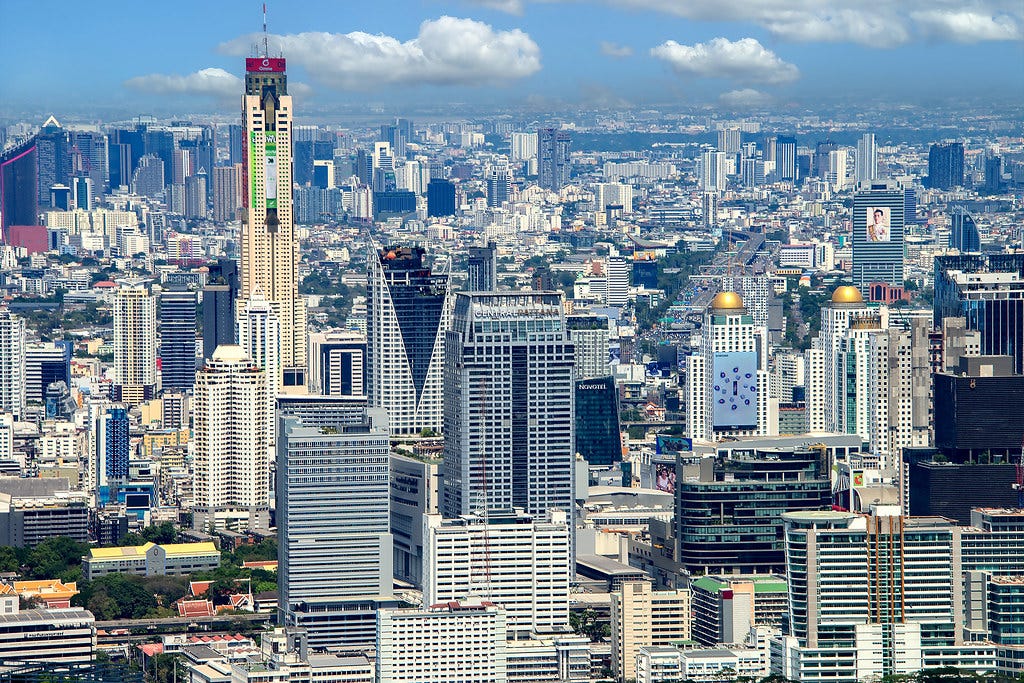Genre of the Day - Luk krung 🇹🇭
Album of the Day - ฮ่วยอะบานิบี by หงษ์ทอง ดาวอุดร (Hongthong Dao-udon) (unclear; likely 1970s)
An oft-repeated factoid centers on the city of Bangkok’s shockingly long full name. That full name comes out to the city of angels, great city of immortals, magnificent city of the nine gems, seat of the king, city of royal palaces, home of gods incarnate, erected by Vishvakarman at Indra's behest. It’s home to nearly 20 million angels, immortals, and gods incarnate, population-wise. Beyond its use as fun fact fodder, the city’s long name indirectly symbolizes its grand stature as southeast Asia’s most iconic cosmopolitan hub, glowing with a globally-known vibrancy and incorporating cultural influences with as much accumulative zeal as its name might suggest.
Bangkok is in a league of its own among cities as reputedly the most visited metropolis in the world, and its sheer level of bustle is illustrated in its weekend market that attracts 200,000 visitors each week. The city’s mass makes Chiang Mai, Thailand’s second largest city set among the northern forest areas, look like a little countryside resort compared to Bangkok’s ostentatious lights and soaring skyline. The fact that Bangkok’s residents are simply referred to as “Khon Krung” in Thai—city people—illustrates its urban dominance. In musical form, luk krung (meaning city child) reflects the zenith of cosmopolitanism in mid-20th century Thailand.
As jazz fanned out from Harlem as the defining cosmopolitan sound across the world in the first half of the 20th century before rock rolled in, it proved to be particularly influential in bridging old traditions to modern pop music in east and southeast Asia’s global hubs. In Shanghai, a fusion of Chinese popular traditions with jazz converged in a bohemian genre called shidaiqu in the late 1920s. As Gerhard Jaiser explains in “Tense Harmony: Thai Cinema and Popular Music,” luk krung’s precedent emerged as Thai composers absorbed the influences of American jazz and dance ensembles passing through Bangkok pre-war. Luk krung’s development musically reflects how urbanized life, which relies on personal hustle and outmaneuvering, creates a culture of individual glory; luk krung became the medium of star-making in Thai film and musical culture by the 1950s and 1960s in its emphasis on individual voices, in contrast to luk thung’s (“children of the fields”) rough-around-the-edges troubadours chronicling rural life. Alongside big band jazz, luk krung increasingly absorbed danceable rhythms from American funk and Latin American dance genres like rumba, chachachá, and bolero as a part of southeast Asia’s curious cross-Pacific purview manifesting in an affinity for Latin American popular music much like Vietnam’s beloved bolero. These blends are less surprising when you consider other Thai genres like wong shadow, in which musicians deftly overlaid surf rock and psychedelic influences with traditional percussion and melodies.
It seems luk krung truly is Bangkok’s domain, as even Spotify doesn’t serve as a proper platform for access—I had to stoop to YouTube for this journey deep into Thai lounges by singer Hongthong Dao-udon. The effort was worth it. “ฮ่วย อะบานิบี” sets the scene, the profound clarity of her voice set against languid, simmering horns that resolve almost too romantically, like a deep sigh. Traditional chime melodies joint he robust march of horns and gently funky bass in “เพลงรักจากหงษ์ทอง” (“Love Song from HongThong”). The wah-wah guitar licks of “กะเดาต้นเก่า” are more funk-inclined as the piano waves to Cuba, bouncing as her feather-light voice soars above. The way her voice weaves its way with these international sounds while fluidly maintaining the melodic stylings of Thai singing is masterful. The groove at 17:42 is incredibly well-crafted—it makes one imagine James Brown making a pitstop in Bangkok to add his signature touches. The city wasn’t built in a day, but in half an hour, this set helps illustrate its glamorous globalism with funk and flair.





